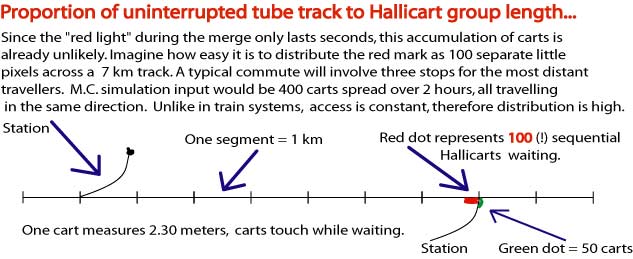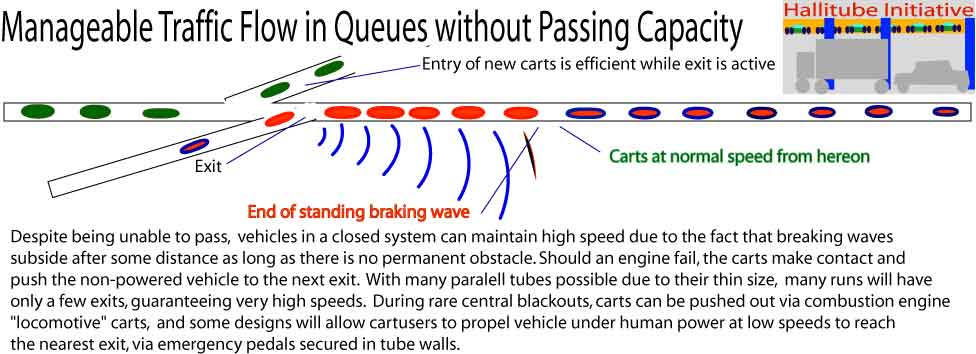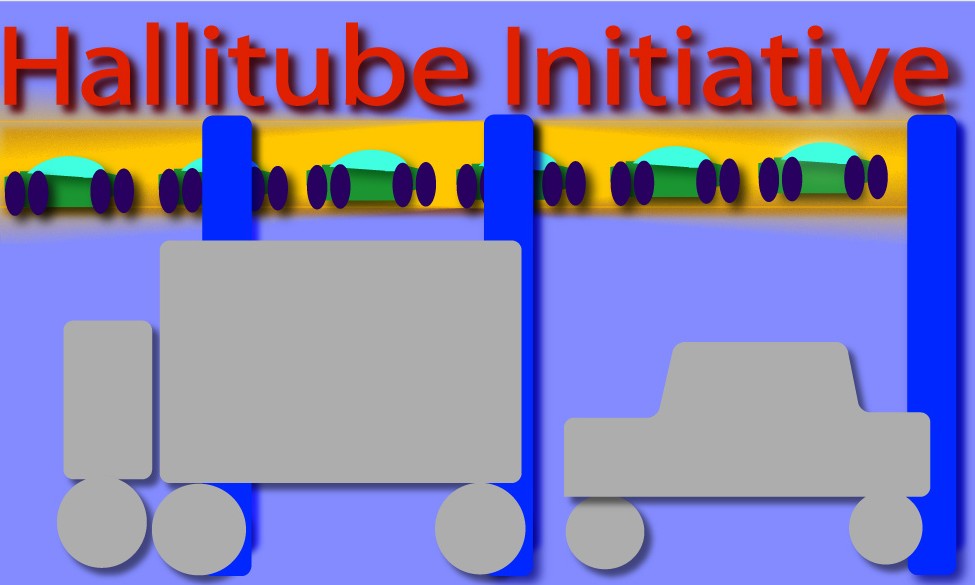
Initially, it would seem that we are developing a great "tube traffic jam". You need a railswitch to move carts off the main tube. And this switch, in railroad terminology has to be "owned" by the user. But there are really two modes of travel here: mixed destination groups and single destination groups of carts. In single destination groups, (say 10-20 carts behind each other, called "platoons" in PRT terminology , the group owns the switch, and they are off the main tube in an instant. Entry onto the main tube is logically always in "highway bound" destination groups, so their entry is extremely rapid also in seconds.. But won't the people who got on just now create a traffic jam when they need to get off at the next exit ? Here is the key: this is not a subway system ! A subway is taken for two stops. Not here. This is commuting oriented. Lots of destination are available but only from a distance. The group that got onto the system downtown can't take an exit just a few miles down the tube. Cars and buses are for that. The cart group is traveling together a minimum distance, typically 10-35 miles, before they get off. The composition of the group determines their separation behavior: If they happen to be all going home to Carlsbad they travel as a pack, almost touching (low mass, cushioned carts). Think of them as a single vehicle. They will own the switch together. If they are a mixed group, a separation signal in the tube indicates for them to brake until they have achieved the minimum distance required for switch resetting. The switch resets in seconds be
 tween the carts. Unlike
in the symbolic diagram below, the actual angle of the exit contains almost
no curve, and can be taken at high speed. Keep in mind again that
a single tube contains only a a third of the exits of the highway above
which it is running. Paradoxically, the more crowded the system gets,
the more self organizing it becomes, as the payoff rises for sequencing
departures intelligently. Incidentally, as the system makes a
steady stream of income, development of non-switch approaches to cart transfer
from and into the highways will proceed. See this diagram of a switchless interface. It is also not
inconceivable that a cart running at low speed could be grasped by a traveling
clamp or suction cups from above, moving it to another track in the absence
of a switch. At this point, many engineers sigh and say well,
since we can't simultaneously implement a whole grid structure of this,
you will end up having a single languishing lane. (Like the LA subway
or the Vegas monorail: underutilized, not paying for themselves. The
answer is here that if the first route is correctly chosen, it
will pay for itself in about 2-3 years, which
tween the carts. Unlike
in the symbolic diagram below, the actual angle of the exit contains almost
no curve, and can be taken at high speed. Keep in mind again that
a single tube contains only a a third of the exits of the highway above
which it is running. Paradoxically, the more crowded the system gets,
the more self organizing it becomes, as the payoff rises for sequencing
departures intelligently. Incidentally, as the system makes a
steady stream of income, development of non-switch approaches to cart transfer
from and into the highways will proceed. See this diagram of a switchless interface. It is also not
inconceivable that a cart running at low speed could be grasped by a traveling
clamp or suction cups from above, moving it to another track in the absence
of a switch. At this point, many engineers sigh and say well,
since we can't simultaneously implement a whole grid structure of this,
you will end up having a single languishing lane. (Like the LA subway
or the Vegas monorail: underutilized, not paying for themselves. The
answer is here that if the first route is correctly chosen, it
will pay for itself in about 2-3 years, which other public
transit systems can't. At that point, investors will come out of the
woodwork, and additional lines will be built not to decongest highway
traffic - but to make money! So, slowly, a second story road system develops.
Think of this as a low cost alternative to lightrails, or where roads
cannot be added.
other public
transit systems can't. At that point, investors will come out of the
woodwork, and additional lines will be built not to decongest highway
traffic - but to make money! So, slowly, a second story road system develops.
Think of this as a low cost alternative to lightrails, or where roads
cannot be added. Are you unconvinced of the ability of endpoints to absorb carts rapidly using your carpet-interface described elsewhere ? Then check here for a pure rail-based storage of the carts, with image.
Scared about switch failures and derailing ? Hi speed junctions are not surrounded by tube walls. Here a large roof covers a safety area filled with compressible material, so that a derailing cart is captured softly. How likely is this ? The switches are designed not to require power to reach completion. In other words, a switch may fail completely, but a gravity based, carefully isolated mechanism guarantees that there is no halting in a "middle" position, which would derail a cart.
Worried about driver behavior and queuing effects ? Despite absence of a central control system, PC based sensors in the tubes feed data to driver to inform them in advance of conditions ahead of them and at upcoming merges. For example, the total number of a group of carts waiting to merge into the main line from a local line will affect the waiting time and cart accumulation in the main line. An early slowing can be exchanged for high-speed riding but then coming to a complete halt. To guide drivers, the upcoming merge situation is shown symbolically with cheap periodic LED boards, and later with wireless networking on a display inside the cart.
Concerned about lengthy main line delays to let people merge ? Are you visualizing a cart with heavy batteries ? This cart does not carry any power source: just a very strong electric motor, the rider, and a streamlined chassis with about 1/4 of the cross section of a motorcycle. Maximum acceleration, unlike on streets, is not voluntary, but mandatory, Cameras observe driver behavior. Any cart deviating from speed parameters is noted. Its driver, and the driver behind it are required to report delays, and if on more than two instances mechanical causes cannot be found, the driver is reprimanded, and in the future may face expulsion. During the merging, 35 carts join the line and are traveling at 60 mph in about 6 seconds, having almost no wind resistance. Note that during the merge acceleration the other carts are not consuming electricity, so the demand on the grid is roughly constant.
Finally, it is a bit unfair to require Hallitubes to have zero congestion. A four line highway system that is busy becomes terribly congested if a truck fails, or if there is a police chase. In these cases all the lines are blocked. Congestion happens. But we have to create more grid space to absorb it, not hold up development of more gridspace for fear that it will be congested.
